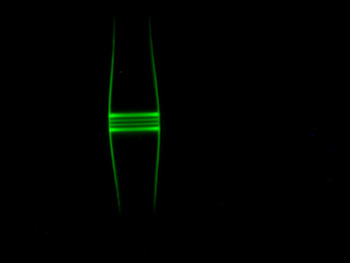
Light runs around a bottle-shaped glass fiber, about half as thick as a human hair. Credit: TU Wien
Researchers from the Vienna University of Technology, Austria, have demonstrated a system where two photons can interact strongly with each other via nanofiber coupled to a tunable resonator (Nat. Photon., doi: 10.1038/nphoton.2014.253). Such a big reaction from such a small amount of light could help make secure quantum channels and optical logic gates possible.
Photons are prime candidates for use in quantum systems because they are easy to transmit over long distances with optical fibers. To transmit information, the photons must interact with each other to “prepare and probe entanglement or to perform quantum logic functions.” But direct photon-photon interaction doesn’t happen naturally. To force the interaction, the team, led by Arno Rauschenbeutel and Jürgen Volz, used a bottle-shaped whispering-gallery-mode resonator interfaced by an optical nanofiber.
For a single photon travelling along the fiber, the detour through the resonator results in a phase shift of 180 degrees; i.e., instead of a wave crest, a wave trough appears. The researchers can couple the resonator with a rubidium atom that almost completely absorbs the photon, preventing a phase shift inversion because it prevents most of the photon’s light from entering the resonator; i.e., you get the expected wave crest. If two photons enter the resonator in succession, the rubidium atom becomes “saturated” after absorbing just one of them. This allows the second photon to enter the resonator and be phase-shifted. Eventually, the atom releases the absorbed photon into the resonator.
But if two photons hit the resonator at the same time, they experience a phase shift inversion together—a direct photon-photon interaction. According to Rauschenbeutel, this creates a “maximally entangled photon state,” which is required for the system to carry information. Per quantum mechanics, there is no difference between these two photons—there’s no way to identify which one is being held by the rubidium atom and which one is passing through the resonator.
What makes this setup potentially useful for quantum computing is the strong interaction it produces with only two photons. In the past, similar systems required bright light with many coupled photons. And since the setup is fully fiber-integrated, it could be compatible with existing optical fiber communications networks.
